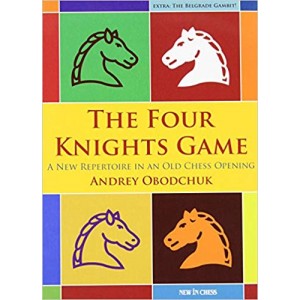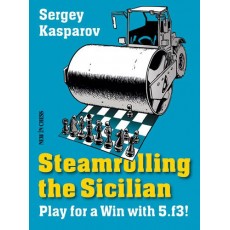Autor: Andrey Obodchuk (Maestru Internațional- Rusia)
Nr. pagini: 238
Limba: engleză
ISBN: 9789056913724
Jocul celor 4 cai, o deschidere veche populara la nivel de club. Ea a fost folosită de mari maestri ca Alexei Shirov și Emil Sutovsky, cu numeroase idei care au schimbat reputația de deschidere pașnică.
The Four Knights Game is one of the oldest chess openings and continues to be a popular choice among beginners and club players. In recent years leading grandmasters such as Alexey Shirov and Emil Sutovsky have injected the Four Knights with numerous fresh ideas and changed its peaceful reputation.
White has quite a few ways to create tension and play for the attack. Russian International Master Andrey Obodchuk has written a repertoire book for white players based on the Spanish Four Knights variation (starting with 4.Bb5).
Covering a range of positional themes as well as sharp and amazing adventures, Obodchuk has created an easy-to-handle toolbox for amateur chess players of intermediate level, as well as a challenging exposition for stronger players.
- A complete opening repertoire in a popular chess opening
- Create attacks from seemingly peaceful positions
- Ideal for club and Internet chess players
- Extra: the Belgrade Gambit, a treacherous sideline!
Andrey Obodchuk is an International Master from Khanty-Mansiysk, Russia. He writes for international chess publications and works as a coach. He was the IPCA (physically disabled) World Chess Champion in 2010 and prolonged this title in 2011.
Introduction
Emanuel Lasker once joked that his only contribution to opening theory was the observation that knights should be developed before bishops. The Four Knights opening illustrates this thesis in ideal fashion. Both sides first place their knights accurately, and then think about what to do further. Joking aside, if such a plan is completely harmless, then how come this simple plan has attracted the interest of such serious players as Shirov, Sutovsky, Nunn, Bacrot, Rublevsky, Short, Motylev and Naer? And, incidentally, what is it that unites these players? This is clear - a creative approach to the game, and a constant willingness to enter into the battle.
In recent times, computers have gone a long way towards proving the truth of the axiom that 'Chess is a draw', steadily analysing out many complicated lines, and ending up with the assessment '00:00'. The silicon monsters have established particularly depressing dead-ends in lines such as the Petroff Defence and the Berlin Wall variation of the Ruy Lopez. But, surprisingly, things are by no means so sad in the Four Knights. Looking through recent games in the Rubinstein Variation 1.e4 e5 2.Nf3 Nc6 3.Nc3 Nf6 4.Bb5 Nd4 5.Bc4 Bc5 6.Ne5, one rather unexpectedly comes across a remarkably large number of white queen sacrifices, although whether these are correct or not is a different question.
It is interesting to compare this trend, which occurs in the supposedly peaceful Four Knights, with the situation in its allegedly much sharper close relative, the Belgrade Gambit, which is highlighted in a separate chapter at the end of the book: Chapter 7. In the majority of variations of this system, which lie off the beaten track of current theory, the play results in an equal ending, unless Black plays in the style of the old masters, and fearlessly accepts all of the sacrifices (1.e4 e5 2.Nf3 Nc6 3.Nc3 Nf6 4.d4 ed4 5.Nd5 Ne4?!).
If White is prepared to play the Four Knights, he must also be ready to face various attempts by Black to avoid this, on the third move. The first chapter of the book is devoted to these lines. It looks at the variation 1.e4 e5 2.Nf3 Nf6 3.Nc3 Bb4: White does not want to allow the Petroff Defence, but Black wants to avoid the Four Knights! Later, we examine Black's attempts to avoid the Four Knights on move three, after 1.e4 e5 2.Nf3 Nc6 3.Nc3, the most popular method being 3 ... g6.
Chapter 2 looks at various rare fourth moves for Black, such as 4...Bc5, 4... a6 and 4...Bd6!. The last of these was not even mentioned in John Nunn's book New Ideas in the Four Knights , published in 1993, since at that time there were no significant practical examples. However, in our day, the system with 4...Bd6 enjoys a degree of popularity that compares with the main lines.
Chapter 3 and 4 are devoted to the classical 1.e4 e5 2.Nf3 Nc6 3.Nc3 Nf6 4.Bb5 Bb4, which is characterised by a complicated strategic battle, with a small advantage for White. (However, Karpov, in his best years, several times outplayed his opponents as Black in this line, showing that here, the knights are not inferior to the bishops, if they are handled by a player of the highest class.)
In Chapter 5 and 6, we look at Akiba Rubinstein's immortal variation, 4...Nd4. Note that after 5.Ba4 Bc5 or 5.Bc4 Bc5, White is not obliged to capture on e5, although it is in precisely these variations that we can witness the amazing adventures and miracles for which we love chess. To be quite frank, it is the recent games in this variation that inspired the author to produce the present work.
Chapter 7 looks at White attempts to squeeze water out of the stone that is the Belgrade Gambit - not an easy task, it must be said.
July-October 2010
Andrey Obodchuk
The Four Knights Game
- Cod produs: 504
- Disponibilitate: În Stoc
-
30,00RON
Produse asemănătoare
1.d4 - Beat the Guerrillas: A Powerful Repertoire Against Annoying Black Sidelines
Aceasta carte acopera un gol in literatura sahista. Dupa 1.d..
30,00RON





